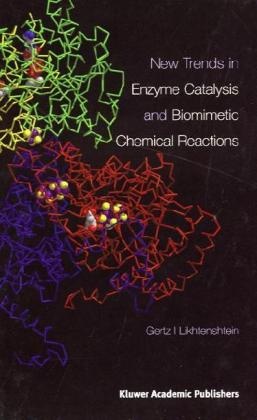Read more
New Trends in Enzyme Catalysis and Biomimetic Chemical Reactions embraces modern areas of enzyme catalysis where other books in the field concentrate mainly on kinetic, bioorganic and biochemical aspects of the enzyme catalysis and do not cover biophysical and physicochemical problems. Topics covered include:
-modern physical and kinetic methods of investigation,
-contemporary theories of elementary chemical processes in enzymes,
-structure, dynamics and action mechanism of enzyme active sites,
-concept of pretransition state,
-theory of long-range electron transfer and proton translocation,
-mechanisms of "tough" biochemical reactions (dinitrogen reduction, light energy conversation, water photooxidation, hydroxilation),
-the achievements and problems of biomimetic chemical reactions.
List of contents
Preface. 1: Methods of investigation of enzymes structure and action mechanisms. 1.1. Physico-chemical methods in enzyme catalysis. 1.2. Kinetic methods. 2: Mechanisms of enzymatic reactions. 2.1. General principles of enzymatic catalysis. 2.2. Electron transfer (ET). 2.3. Hydrogen transfer. 2.4. Electron-proton coupling. Mechanism of ATPase reactions in energy-conversion systems. 2.5. Concerted reactions. 2.6. Multi-electron mechanisms of redox reactions. Switching molecular devices. 2.7. Stabilization of enzyme reactions transition states. 2.8. Pretransition states. 2.9. Principle of 'optimum motion' and mechanisms of enzymes reactions. 2.10. Radical mechanisms of enzyme catalysis. 2.11. Substrate channeling. 2.12. Relationships between the energy and entropy activation of enzymatic processes. 3: Mechanisms of chosen enzyme systems. 3.1. Nitrogenase. 3.2. Cytochrome P-450. 3.3. Methane monooxigenase. 3.4. Nitric oxide synthase. 3.5. Light energy conversion and water-oxidation systems in photosynthesis. 4: Some properties important for enzyme catalysis. 4.1. Intramolecular dynamics and conformational transitions in enzymes. 4.2. Electrostatic effects in proteins and enzymes. 4.3. Enzymes from extreme thermophylic bacteria. 5: Areas related to enzyme catalysis. 5.1. Antibody catalysis. 5.2. Enzymes in organic solvents. 5.3. Enzymes in synthetic chemistry. 5.4. Enzymes design and redesign. 6: Model chemical systems. 6.1. General principles. 6.2. Reduction of dinitrogen. 6.3. Hydroxylation of organic compounds. 6.4. Light energy conversion. 6.5. Water oxidation. 6.6. Organic reactions. References. Index.
About the author
Gertz Likhtenshtein has been full Professor at the Ben-Gurion University of Negev (Israel) and emerited 2003. Among his many awards are the Medal of the Exhibition of Economic Achievement, the Diploma of Discovery, the USSR State Price and the Diploma of the Israel Chemical Society. He is a member of the International ESR Society, the American Biophysical Society, the Israel Chemical Society and the Israel ESR Society.
Summary
Topics covered include: modern physical and kinetic methods of investigation, contemporary theories of elementary chemical processes in enzymes, structure, dynamics and action mechanism of enzyme active sites, concept of pretransition state, theory of long-range electron transfer and proton translocation, and more.

